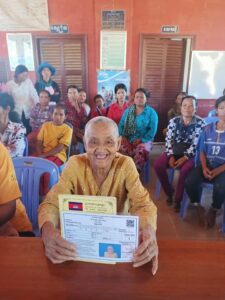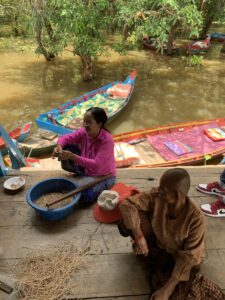Authoritarian Resiliency: Cambodia’s Politics of Social Protection Policy
April 11, 2024

Dr Soksamphoas Im, 2024 LKC NUS-Stanford Fellowship awardee, is visiting FASS from 8 April to 31 May 2024. She is working on ‘Authoritarian Resiliency: Cambodia’s Politics of Social Protection Policy’, a research project and future book that examines Cambodia’s National Social Protection Policy Framework 2016-2025’s IDPoor Program. The project builds on her dissertation research on the politics of the Cambodia National Ageing Policy 2017-2023 and on scholarship by Huang (2014) on social protection under authoritarianism in the People’s Republic of China. Her research has been published in Ageing and Social Policy, Journal of Industrial Relations, Asian Politics & Policy, Annals of Tourism Research Empirical Insights, Asian Studies Review, and is forthcoming in Routledge Handbook of Autocratization in Southeast Asia, Politics & Policy, Southeast Asian Studies, Pacific Affairs, and Social Policy & Administration.
We interviewed Dr Im, who is an Associate Director with the Asian Studies Center (ASN) at Michigan State University and an affiliated scholar at the Center for Southeast Asian Studies, at the University of Michigan, Ann Arbor, about her study.
1. What sparked your interest in researching the politics of social protection policy in Cambodia?

My interest in investigating the political dynamics of social protection policy in Cambodia was initially kindled during my doctoral research, which scrutinized the Cambodian National Aging Policy 2017-2030. While my primary objective was to ascertain the impacts of this policy on elderly Cambodians, an in-depth exploration of its formulation, implementation, and resultant outcomes gradually prompted me to contemplate the underlying rationale behind the Cambodian government’s decision to expand its social assistance program. This decision, notable in the context of Cambodia’s status as a low-income nation and amidst a backdrop of political constraints following the contentious election of 2013, presented a compelling puzzle. Through a meticulous examination of the policy’s efficacy, my analysis culminated in the identification of the aging policy as an integral component of the broader state agenda, namely the national social protection policy framework. This framework, strategically aligned with the longstanding governance objectives of the ruling CPP (Cambodian People’s Party) government, underscores a concerted effort to enhance governance practices. It is this intriguing nexus between policy, politics, and governance that motivates my ongoing inquiry into the politics of social protection policy in Cambodia.
2. Why is it important for us to study social protection policymaking in authoritarian states and its effects on stakeholders?

Examining social protection policymaking in authoritarian states is crucial as it illuminates the dynamics of governance, power structures, and state-society relations within these contexts. Understanding the formulation and implementation of social protection policies in authoritarian regimes helps reveal the extent of state control, patterns of resource distribution, and their impact on various stakeholders, including marginalized groups and dissenting voices. These insights are invaluable for evaluating policy effectiveness, identifying avenues for enhancement, and advocating for the rights and welfare of vulnerable populations in restrictive political environments.
3. Why did you select the provinces of Takeo, Kampot, and Kampong Speu as your fieldwork sites?
I chose these sites (Takeo, Kampot, and Kampong Speu) primarily because of their convenient geographical proximity to Phnom Penh’s capital. Additionally, I established contacts within the local community to facilitate interviews with beneficiaries of social protection policies, such as recipients of IDPoor cash assistance. Furthermore, budget constraints played a role in the selection process.
4. What challenges do you anticipate encountering when carrying out your fieldwork?
The challenges I faced, as well as those anticipated during follow-up interviews, revolved primarily around securing and nurturing trust within the local community and among pertinent stakeholders such as NGOs and government officials. Seeking their consent for interviews was a crucial aspect. Ensuring the safety of enumerators and averting any potential suspicion from village authorities or guards while in the field was another significant concern. This became particularly pertinent due to the heightened surveillance by the Cambodian government in local communities in recent years.
5. Have any other nations in Asia, like Cambodia, replicated the Chinese poverty welfare programme? If so, how do they compare to how Cambodia has done it?

Some Asian countries, such as the Philippines and Thailand, have implemented cash assistance programs akin to China’s welfare program, Dibao, and Cambodia’s IDPoor program. For instance, the Philippines’ Pantawid Pamilyang Pilipino Program (4Ps) represents the government’s inaugural conditional cash transfer and rice subsidy initiative targeting impoverished demographics. Comparable to Cambodia’s IDPoor program, the 4Ps program integrates explicit poverty-targeting mechanisms and furnishes short-term cash support to disadvantaged households, concurrently fostering the human capital development of their children with the overarching objective of breaking the poverty cycle. Despite facing numerous criticisms regarding its efficacy, the 4Ps program has been appropriated by presidential candidates as a strategy to garner more votes. This mirrors the situation in Cambodia, where the IDPoor Program gained widespread implementation subsequent to the dissolution of the main opposition party, serving as a tool for the ruling party to bolster its popularity and rally support from the working class and impoverished populace, who constitute the program’s beneficiaries.
6. What are some ways in which Cambodia’s IDPoor has been successful? How could it be improved?

Since its inception, the IDPoor cash assistance program has played a pivotal role in combating poverty in Cambodia. By offering support to individuals teetering on the edge of poverty and alleviating hunger among those entrenched in destitution, the program has effectively prevented further economic decline. Moreover, IDPoor beneficiaries have gained access to essential healthcare services at public hospitals and community clinics without financial barriers, aligning with the Cambodian government’s objective of enhancing healthcare accessibility. Despite its notable impact, the program still faces challenges, particularly concerning implementation. Many deserving individuals have not received IDPoor cards, highlighting the need for enhanced transparency in the beneficiary identification process, particularly at the commune and village levels. Ensuring equitable distribution and transparency remains imperative for the program’s continued success in addressing poverty in Cambodia.
7. What are some other possible strategies that policymakers could utilize (in tandem or separately) to reduce poverty in Cambodia?

To further combat poverty in Cambodia, policymakers should explore additional strategies alongside social welfare initiatives like the IDPoor cash assistance program. While such safety nets are crucial for those facing immediate economic hardships, a comprehensive approach is necessary. Long-term policy considerations include:
- Enhancing human capital by expanding access to high-quality skills training, particularly in areas such as technology, to meet the demands of the modern job market.
- Reforms in the legal and tax systems to attract and retain foreign investment, thus stimulating job creation and economic growth.
Increased investment in the agricultural sector to boost productivity and facilitate market access for farmers, thereby bolstering rural livelihoods and reducing poverty in rural areas.
Thank you very much for taking the time to share your research with us, Dr Im. We wish you success in your studies in and beyond Southeast Asia!

